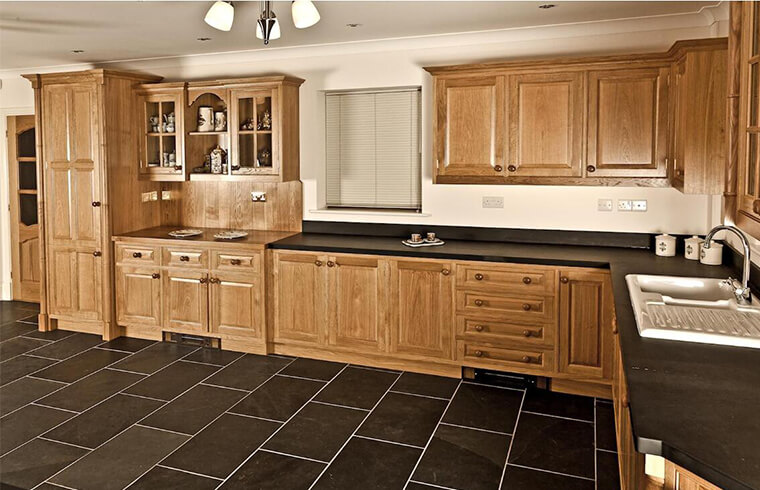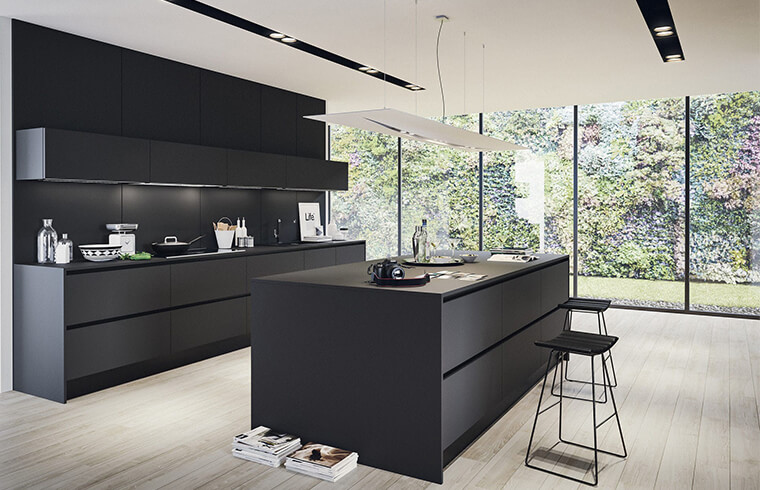Choosing the right kitchen cabinets is a critical decision in kitchen design, as it defines both the look and functionality of the space. Among the many options, solid wood cabinets and wood veneer cabinets often stand out. Understanding their differences and similarities can help you make an informed choice.
Solid wood cabinets are a timeless choice, known for their durability and natural beauty. Here’s a closer look at their key characteristics:
Solid wood cabinets come in various species, each offering distinct aesthetics:
Maple, Oak, and Birch: Widely available and affordable, these species provide a warm, natural look. Maple has a smooth and light appearance, while oak features a prominent, rustic grain. Birch offers a subtle and consistent texture.
Walnut and Cherry: These premium species are prized for their rich colors and fine grain, making them more expensive but elegant options.
When it comes to appearance, solid wood cabinets truly shine. As natural products, no two pieces will be exactly alike. The variations in the wood, from the knots to the subtle differences in grain pattern, give each cabinet a one-of-a-kind look. This can create a beautiful and idiosyncratic kitchen design. However, if you plan to paint the cabinets, the natural grain may be hidden beneath the primer and paint. In such cases, paint-grade woods like birch or maple are often preferred. Painting offers a more vibrant color palette and greater customization options, but it's important to note that natural wood's tendency to expand and contract with temperature and humidity changes can lead to joint cracking in painted finishes.
Painted Cabinets: Provide a vibrant, customizable color palette but may develop cracks in the joints due to wood’s natural expansion and contraction.
Stained Cabinets: Enhance the wood’s natural grain and texture, creating a rich, translucent finish. However, stains can sometimes adhere unevenly due to the wood’s natural inconsistencies.
Worn & Distressed Cabinets: Techniques like sanding edges or adding intentional marks give cabinets a rustic, aged look, perfect for farmhouse or vintage kitchen styles.
Solid hardwood options are strong and reliable for daily kitchen use. However, they are susceptible to warping over time due to changes in temperature and humidity. Liquid or excessive moisture can also cause warping. The strength and durability can vary slightly depending on the species, with maple being relatively stronger than birch, for instance.
The price depends on the wood species and finish. Affordable options like birch or oak are budget-friendly, while walnut or cherry cabinets are more expensive. Painted finishes generally cost 10-15% more than stained ones due to additional labor.

While solid wood cabinets have their own charm and qualities, wood veneer cabinets present an interesting alternative that merits a closer examination. As we shift our focus from solid wood to wood veneer, it's essential to understand the fundamental aspects that define this option, beginning with what exactly wood veneer is and how it is crafted to offer a distinct yet comparable cabinetry solution.
Wood veneer cabinets provide an alternative that offers the look and texture of natural wood at a reduced cost. They are made by adhering a thin sheet of real wood onto an underlying substrate, usually particleboard. Wood veneer is available in the same wood species as solid door options, allowing for a wide variety of choices. It's also a great way to incorporate exotic woods like bamboo and mahogany that might be harder to source for solid wood cabinetry.
In appearance, wood veneer can closely mimic solid wood, with the same unique natural wood grain patterning. However, some wood veneers may be produced in thin strips, which could result in a fluctuated grain pattern. But more popular species like maple or oak are often produced in wider sheets, making the grain look just as consistent as solid wood. When it comes to painted finishes, wood veneer can be painted with similar quality as solid wood or MDF cabinets. Oak, in particular, can give a distinct quality to painted wood veneer cabinets due to its uneven and coarse grain. For stained finishes, wood veneer has an advantage as it won't have as blotchy or uneven a finish as solid wood. This is because the particleboard substrate is thick relative to the veneer sheet, preventing the stain from seeping through and causing an uneven appearance.
Painted Cabinets: Wood veneer can be painted with the same quality of solid wood or MDF cabinets. Just like their solid wood counterparts, maple and birch, wood veneers offer beautiful, paint-grade materials. Oak is another species that can be used for painted wood veneer cabinets. With that being said, oak’s grain has an uneven and coarse texture, unlike the smoother surfaces of maple and birch. This makes oak a fantastic choice if you want your painted wood veneer cabinets to have a more distinct quality to them.
Stained Cabinets: Wood veneer won't have as blotchy or uneven a stained finish as solid wood, simply because the particleboard substrate is so thick relative to the veneer sheet. The thin surface sheet of wood veneer means the stain won't seep through the depth of the door, causing a blotchy or uneven finish.
Wood veneer cabinets are reasonably durable but come with specific vulnerabilities. The primary concern is water damage—if moisture penetrates the veneer and reaches the particleboard core, it can cause expansion, leading to the veneer loosening or "bubbling." Additionally, corners and edges are prone to chipping, which may result in peeling and expose the underlying substrate. To improve durability and minimize chipping, solid wood edging can be used. Despite these challenges, the particleboard substrate offers better stability than solid wood, making wood veneer cabinets less prone to warping or shape changes caused by temperature and humidity fluctuations.
In terms of cost, wood veneer is generally a cheaper alternative to solid wood. For example, by simply swapping the solid oak centre panel of a cabinet door with an oak veneer panel, significant cost savings can be achieved. Depending on the size of the kitchen, this basic change can result in thousands of dollars in savings.

Despite their differences, both wood veneer doors and solid wood have similar appearances. After all, they are both made from wood with natural grain. Just like any wood piece, both types of cabinet doors will vary from piece to piece due to natural differences in the grain. In some wood veneer doors, you may notice some fluctuations in the grain that may point to the fact that they are not solid wood, depending on the type of wood used and the manufacturer. This is more common if the wood veneers are placed on the door in thin strips as opposed to wider sheets. However, in many cases, wood veneer doors can look just like solid wood doors.
The biggest vulnerability of solid wood cabinet doors is their reaction to temperature and humidity changes. Solid wood expands and contracts in response to changes in temperature and humidity. This is a natural and inevitable process, but it can lead to the wood warping over time. With this being the only drawback, solid wood is a reliable choice for strong cabinet doors. On the other hand, wood veneer cabinet doors are more vulnerable to water damage. If water is able to find its way behind the veneer and into the particleboard, it can cause the door to expand or cause the veneer to loosen. Wood veneer cabinet doors are also susceptible to chipping and peeling. A chip on the edge or corner of a wood veneer door can cause the facing of the doors to peel and reveal the particleboard underneath. One workaround for this is to use solid wood around the edges of the door to reinforce them. Although they are not completely resistant to warping or changing shape, wood veneer cabinet doors are a bit more resilient than solid wood doors in this area. The particle board underneath the veneer is more stable than solid wood and less likely to lose its form.
Because solid wood cabinet doors are made of natural wood all the way through, they tend to cost a bit more than wood veneer doors. However, the cost of wood cabinet doors will vary widely depending on the type of wood you use. Regardless, you can expect wood veneers to be the cheaper option since the material beneath the veneer is cheaper to produce. Eventually, it comes down to what features of each you value most.
In conclusion, both solid wood and wood veneer kitchen cabinets have their own set of advantages and disadvantages. Solid wood offers a classic, natural look with the potential for unique customization through techniques like distressing. It is strong and durable, although prone to warping and more expensive. Wood veneer, on the other hand, provides a cost-effective option with a similar appearance, better stability in some aspects, and advantages in finishes like staining. When deciding between the two, homeowners need to consider factors such as budget, desired aesthetic, durability requirements, and the kitchen's overall design and functionality. By carefully weighing these aspects, one can select the cabinet material that best suits their individual needs and creates a beautiful and functional kitchen space.
We employ cookies to analyze website traffic and enhance your browsing experience. Data securely aggregated, privacy protected. See Privacy Policy for details.